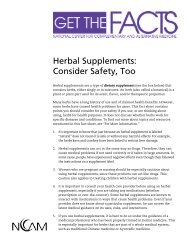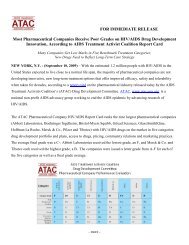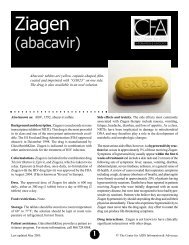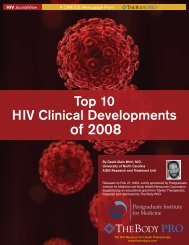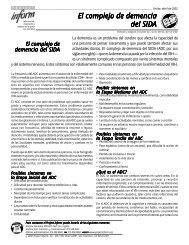WELLNESS STARTS WITH AWARENESS - CD8 T cells - The Body
WELLNESS STARTS WITH AWARENESS - CD8 T cells - The Body
WELLNESS STARTS WITH AWARENESS - CD8 T cells - The Body
You also want an ePaper? Increase the reach of your titles
YUMPU automatically turns print PDFs into web optimized ePapers that Google loves.
hormone, that he had been injecting himself with a low dose for<br />
about seven years, and that growth hormone was why he looked<br />
lean and youthful.<br />
Bingo, I thought, that’s what I want. I’m a 42-year-old Polish<br />
guy who’s put on a belly through beer and bad habits. I know what<br />
this particular body shape should look like. But when I looked in<br />
the mirror I saw something diff erent. I saw a huge barrel belly, an<br />
oddly fat neck and jowls. Protruding from this mass was skinny,<br />
scrawny arms and legs. I felt like an apple on toothpicks.<br />
I’ve been HIV-positive for more than 20 years. I’ve spent 15 of<br />
those years on HIV meds. Don’t get me wrong, I’m thrilled to be<br />
alive. I’m grateful for the meds, but they left their mark on my body.<br />
Th e physical changes from the meds were undeniable. I wasn’t just<br />
getting older and soft er. Th e shape of my body had changed dramatically<br />
and not in a good way. Aft er speaking with Steve, I decided<br />
to do something about it.<br />
I did what the pharmaceutical commercials tell me: I asked my<br />
doctor if growth hormone was right for me. Oddly, he got a little<br />
nervous. You don’t really have AIDS wasting, he mumbled, adding<br />
that there are a lot of side eff ects. Instead,<br />
he suggested a surgical procedure where<br />
my stomach is permanently clamped off by<br />
a band that’s implanted in the body. Th is<br />
option seemed extreme.<br />
Coincidentally, I heard about an experimental<br />
drug called tesamorelin, which<br />
supercharged your body to kick up its own<br />
natural levels of growth hormone. Soon, I<br />
joined a clinical trial of tesamorelin to treat<br />
HIV-associated belly fat. Just recently, I<br />
completed the year-long trial. Now, I have<br />
the unique opportunity to assess how human growth hormone has<br />
changed my life.<br />
A hangover from the AIDS cocktail<br />
It was around 1996 when the success of the “AIDS cocktail”<br />
made headlines. It was a breakthrough. For the fi rst time, HIV<br />
medicine was good enough to essentially snuff out the virus and<br />
start to save lives. It was a welcomed change of course for a beleaguered<br />
patient community. So it almost seemed inconsequential in<br />
the very beginning when anecdotes of strange body-shape changes<br />
fi rst began to emerge as a side eff ect of the medicine.<br />
Th e AIDS cocktail got its name because it combined three different<br />
classes of HIV drugs.<br />
One class is the protease inhibitors, of which indinavir is a<br />
member. Indinavir is the generic name of the drug and Crixivan is<br />
the brand name. Another class is the nucleoside analogs, of which<br />
zidovudine and stavudine are members. Stavudine’s brand name is<br />
Zerit. Zidovudine’s brand name is Retrovir, but it’s better known<br />
as AZT. It’s also one ingredient in various combination pills by the<br />
names Combivir, Epzicom, and Trizivir.<br />
As body-shape side eff ects emerged among patients taking the<br />
cocktail, the changes sometimes got informally named as AZT butt<br />
or Crix belly. It seemed that the nucleoside analogs were associated<br />
PA • September / October 2008 • tpan.com • positivelyaware.com<br />
Positively Aware<br />
with fat loss in the buttocks, legs, arms, and cheeks. On the other<br />
hand, the protease inhibitors were associated with fat gain in the<br />
stomach, jowls, and neck. Another distressing condition was a disfi<br />
guring accumulation of fat at the base of the neck called “buff alo<br />
hump.”<br />
Over time, the anecdotes could not be ignored. As researchers<br />
examined the issue more closely, they also found unusually high<br />
levels of cholesterol and triglycerides in the blood of patients taking<br />
protease inhibitors. Th e range of conditions baffl ed doctors, but one<br />
thing was clear: the common denominator was fat.<br />
“Fat loss is clearly associated with stavudine and to a lesser<br />
extent, zidovudine,” said Valerianna Amorosa, M.D. She is chief of<br />
Infectious Diseases at the Philadelphia Veterans Hospital in Pennsylvania.<br />
Her clinical practice and research focuses on conditions<br />
related to HIV, hepatitis C, and obesity. As for the cause of buff alo<br />
hump, she said the jury is still out. “We thought it was the protease<br />
inhibitors, but I don’t think it’s that simple any more.”<br />
Th ese days, the trend is to distinguish between weight gain<br />
and weight loss as separate and distinct conditions. Weight loss in<br />
When Steve turned the corner<br />
and I saw him, once again I was<br />
struck by his lean and youthful<br />
appearance.<br />
the butt, legs, arms, and cheeks is called lipoatrophy. Weight gain<br />
around the belly is called excess visceral adipose tissue, which is<br />
abbreviated as VAT. I prefer to use the lowercase vat because it’s<br />
similar to fat, but still diff erent. Too much vat gives your body an<br />
apple shape, with fat growing between internal organs. Gardenvariety<br />
fat tends to distribute itself more evenly and stays just below<br />
the skin where it’s less harmful.<br />
Sometimes, it’s hard to tell the diff erence between fat and vat,<br />
notes Amorosa. Th e commonly used body mass index, also called<br />
BMI, is not a great indicator of the risks associated with being overweight.<br />
Vat is linked to high blood pressure, diabetes, high cholesterol,<br />
and high triglycerides. Th e diff erence between vat and fat is<br />
where the fat lives on the person. “In somebody who has a BMI of<br />
26, but who doesn’t have a big belly, who has a relatively fl at belly,<br />
and has some weight in the trunk or in the bottom, I don’t worry<br />
as much about them.”<br />
High levels of cholesterol and triglycerides or glucose problems<br />
are collectively referred to as metabolic syndrome. A surprising<br />
study in 2007 found the prevalence of metabolic syndrome among<br />
people with HIV is not any higher than that of the general population.<br />
Metabolic syndrome, it seems, has less to do with HIV medicine<br />
and more to do with beer and bad habits.<br />
29








